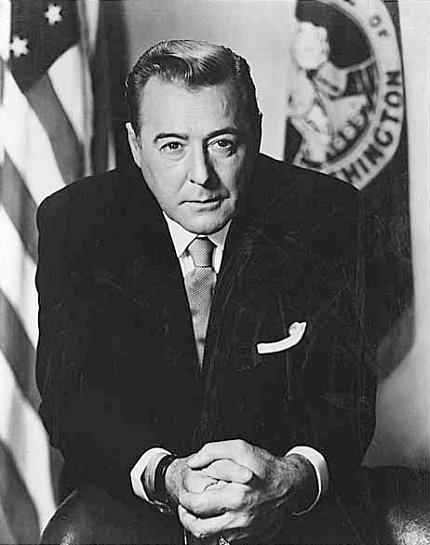80-Year Anniversary
Hospital Namesake Ended Chinese Exclusion

Former legislator Warren G. Magnuson has many connections to the NIH. In 1937, he sponsored legislation to establish the National Cancer Institute. And his name is appended to the Warren G. Magnuson Clinical Center, which opened in 1953 and has hosted hundreds of thousands of patients since.
But the former senator and representative from the state of Washington from 1937 to 1981 is also tied to Americans of Asian heritage through his repeal of the Chinese Exclusion Act.
Passed by Congress in 1882, the Chinese Exclusion Act provided an absolute 10-year ban on Chinese laborers and effectively prevented people of Chinese descent from immigrating to the United States.

The legislation also placed new requirements on people of Chinese descent who were already in the country, removing the possibility of U.S. citizenship and making it difficult to return to America if they left the country.
Congress extended the legislation when it expired in 1892 and made it permanent in 1902, adding new restrictions that required Chinese residents to register and obtain a certificate of residence. Those who failed to do so faced deportation.
Magnuson sponsored the Chinese Exclusion Repeal Act of 1943 (commonly called the Magnuson Act) and Congress repealed the discriminatory exclusion laws and permitted some Chinese immigrants already residing in the country to become naturalized citizens.
“They will now say that China is now on the same basis in the minds and hearts and spirit of the American people as all other countries,” said Magnuson, in testimony before the House Committee on Immigration and Naturalization in May 1943.
President Franklin D. Roosevelt supported the measure and signed the repeal into law, saying in a letter to Congress that the legislation corrected the “historic mistake” of Chinese exclusion.

“It is with particular pride and pleasure that I have today signed the bill repealing the Chinese Exclusion Laws,” said Roosevelt after signing the legislation in December 1943. “The Chinese people, I am sure, will take pleasure in knowing that this represents a manifestation on the part of the American people of their affection and regard.” (Read the full statement at: www.presidency.ucsb.edu/node/209745.)
The legislation opened up quota-based immigration, with 105 people with Chinese backgrounds allowed to apply for citizenship each year.
Congress finally ended all quotas on immigrants based on their national origin when it passed the Immigration Act of 1965.

Some 16 years later, in a statement read at the October 1981 dedication of the CC, Magnuson reinforced his support of inclusivity and NIH’s commitment to health for all: “I was proud to have played a part in establishing the NIH, but more so, in helping over the ensuing years, to see that their missions were adequately funded. That confidence in their professional ability that faith, was shared by others in Congress, including the Secretary. If I could be there at the ceremony, I would counsel those at the NIH not to become overly concerned about fiscal cutbacks of the moment or budgetary politics. The missions of NIH are far too important to be ignored, or shortchanged, for more than a fleeting moment.”
